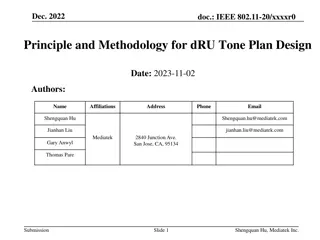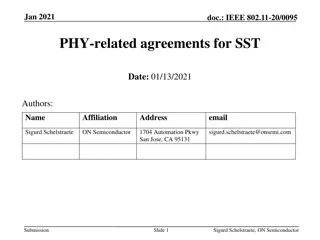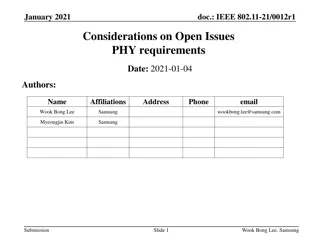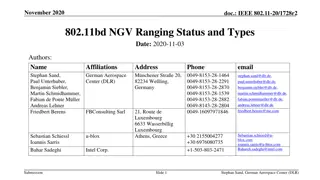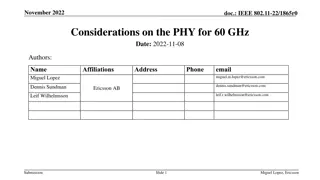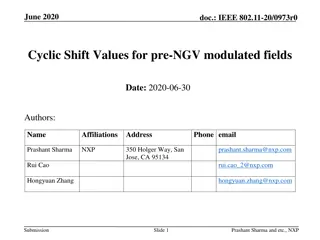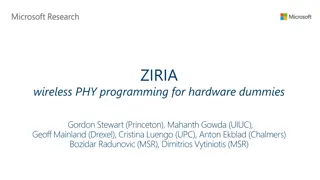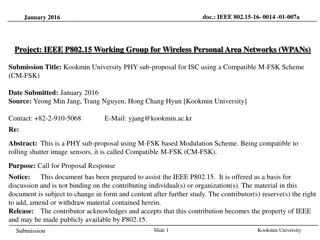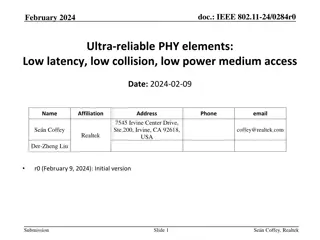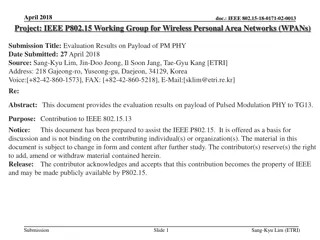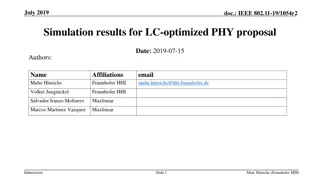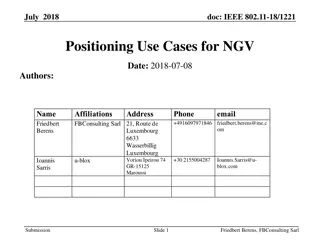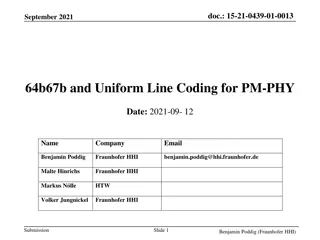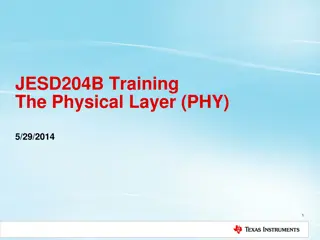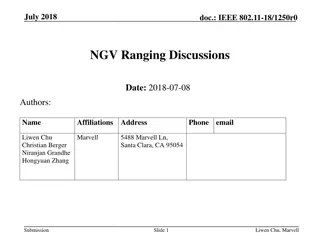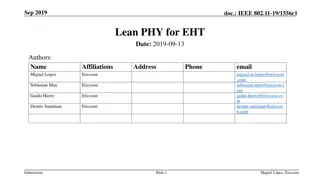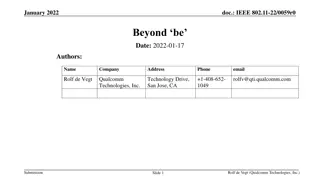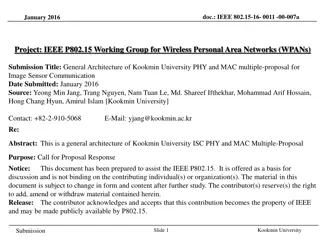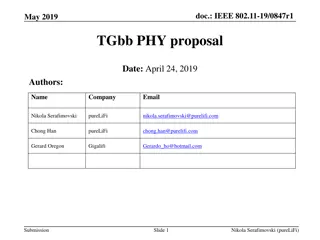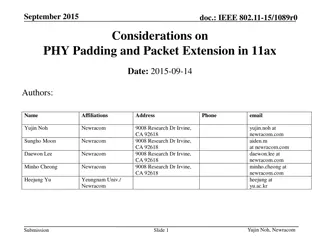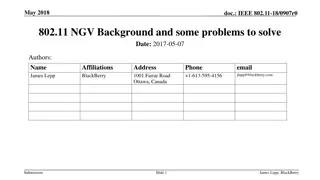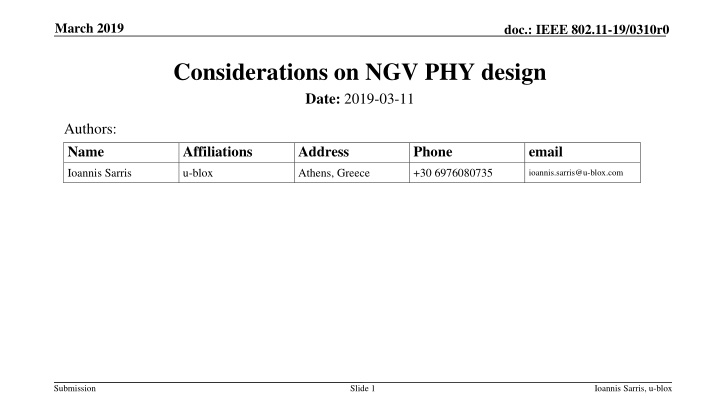
NGV PHY Design Considerations for V2X Communications
Explore investigations into potential features of an NGV PHY design for V2X communications, including channel tracking, forward error correction, and OFDM tone plan optimizations. Discover the implications of Data-Aided Channel Estimation (DACE) and Midamble Channel Estimation (MCE) mechanisms. Evaluate the performance and suitability of these features in enhancing V2X communication scenarios effectively.
Download Presentation

Please find below an Image/Link to download the presentation.
The content on the website is provided AS IS for your information and personal use only. It may not be sold, licensed, or shared on other websites without obtaining consent from the author. If you encounter any issues during the download, it is possible that the publisher has removed the file from their server.
You are allowed to download the files provided on this website for personal or commercial use, subject to the condition that they are used lawfully. All files are the property of their respective owners.
The content on the website is provided AS IS for your information and personal use only. It may not be sold, licensed, or shared on other websites without obtaining consent from the author.
E N D
Presentation Transcript
March 2019 doc.: IEEE 802.11-19/0310r0 Considerations on NGV PHY design Date: 2019-03-11 Authors: Name Affiliations Address Phone email Ioannis Sarris u-blox Athens, Greece +30 6976080735 ioannis.sarris@u-blox.com Submission Slide 1 Ioannis Sarris, u-blox
March 2019 doc.: IEEE 802.11-19/0310r0 Abstract This contribution presents a number of investigations regarding potential features of an NGV PHY. These attempt to quantify the performance and evaluate the suitability of such features. Open source 802.11p model [1] available at: https://github.com/u-blox/ubx-v2x Model with potential NGV features available at: https://github.com/u-blox/ubx-v2x/tree/ngv_ldpc_mce Submission Slide 2 Ioannis Sarris, u-blox
March 2019 doc.: IEEE 802.11-19/0310r0 Introduction The investigations presented here are focusing on: Channel tracking Forward error correction OFDM tone plan Other contributions have presented interesting and valuable simulation results by jointly considering multiple modifications to the 11p PHY. We believe that, whenever possible, it is important to evaluate each proposed new feature individually in the context of a V2X communications scenario. Moreover, we think that today s state-of-the-art should be used as a basis for any comparison. Submission Slide 3 Ioannis Sarris, u-blox
March 2019 doc.: IEEE 802.11-19/0310r0 Topic 1 Channel Tracking Submission Slide 4 Ioannis Sarris, u-blox
March 2019 doc.: IEEE 802.11-19/0310r0 Data-Aided Channel Estimation (DACE) Legacy frame format was designed assuming that the channel coherence time is greater than the maximum packet duration This assumption is violated in most V2X scenarios even at moderate speeds Current state-of-the-art V2X chipsets usually involve a Data-Aided Channel Estimation (DACE) scheme for tracking the wireless channel Fig. Block diagram of DACE, taken from [2] Submission Slide 5 Ioannis Sarris, u-blox
March 2019 doc.: IEEE 802.11-19/0310r0 Midamble Channel Estimation (MCE) Midamble Channel Estimation (MCE) is an alternative channel tracking mechanism which uses reference symbols in-between DATA symbols This simplifies reception at the expense of efficiency M(preamble not taken into account) ??= ?+1 e.g. 2 = 66.7%, 4 = 80.0%, 8 = 88.9% ? 802.11p STF LTF SIG DATA DATA DATA DATA DATA DATA DATA DATA DATA DATA Midamble format (e.g. M=4) DATA MID DATA DATA MID STF LTF SIG DATA DATA DATA DATA DATA M=4 M=4 Submission Slide 6 Ioannis Sarris, u-blox
March 2019 doc.: IEEE 802.11-19/0310r0 DACE vs MCE - Simulation parameters PHY: 1. 2. Channel models [3]: Rural LoS (144 km/h, low frequency selectivity) Highway NLoS (252 km/h, high frequency selectivity) MCS: 0, 2, 4, 6 Payload length: 400 bytes Standard 802.11p with DACE 802.11p with midamble fields ( LTF, 8us @ 10 MHz) and MCE Submission Slide 7 Ioannis Sarris, u-blox
March 2019 doc.: IEEE 802.11-19/0310r0 DACE vs MCE - Rural LoS PER DACE imposes a time offset between channel estimation and symbol equalization This offset depends on the MCS and Viterbi trace-back length A new estimate is obtained on every DATA OFDM symbol (allows averaging) MCE also has a time offset between 1 and M symbols (no averaging possible) PER vs SNR simulations show MCE M=4, similar or better performance than DACE MCE M=8, worse performance than DACE Submission Slide 8 Ioannis Sarris, u-blox
March 2019 doc.: IEEE 802.11-19/0310r0 DACE vs MCE - Rural LoS Throughput Throughput simulations show: DACE performance is globally better than MCE Top throughput is reduced as expected DACE: = 100% MCE: 2 = 66.7% 4 = 80.0% 8 = 88.9% Submission Slide 9 Ioannis Sarris, u-blox
March 2019 doc.: IEEE 802.11-19/0310r0 DACE vs MCE Highway Non-LoS PER PER vs SNR simulations show: MCE M=4, similar performance to DACE MCE M=8, worse performance than DACE Submission Slide 10 Ioannis Sarris, u-blox
March 2019 doc.: IEEE 802.11-19/0310r0 DACE vs MCE Highway Non-LoS Throughput Throughput simulations show: DACE performance is globally better than MCE M=4 seems to give the best tradeoff between the different MCE schemes Submission Slide 11 Ioannis Sarris, u-blox
March 2019 doc.: IEEE 802.11-19/0310r0 Topic 2 Forward Error Correction Submission Slide 12 Ioannis Sarris, u-blox
March 2019 doc.: IEEE 802.11-19/0310r0 Forward Error Correction The use of enhanced FEC schemes are obvious candidates for 802.11bd LDPC was introduced with 802.11n Provides significant gains in standard indoor/low-mobility scenarios Here the performance of LDPC is evaluated in the context of V2X comms The high latency of LDPC decoding* makes it unsuitable for use in conjunction with a DACE scheme *as defined in 802.11n Submission Slide 13 Ioannis Sarris, u-blox
March 2019 doc.: IEEE 802.11-19/0310r0 BCC vs LDPC - Simulation parameters PHY: 1. 2. Channel models: Rural LoS (144 km/h, low frequency selectivity) Highway NLoS (252 km/h, high frequency selectivity) MCS: 0, 2, 4, 6 Payload length: 400 bytes Standard 802.11p with BCC & DACE 802.11p with LDPC & MCE Submission Slide 14 Ioannis Sarris, u-blox
March 2019 doc.: IEEE 802.11-19/0310r0 BCC vs LDPC Rural LoS PER PER vs SNR simulations show: LDPC gives a 2-3 dB enhancement in PER performance compared to DACE Performance also depends on the MCE scheme used Submission Slide 15 Ioannis Sarris, u-blox
March 2019 doc.: IEEE 802.11-19/0310r0 BCC vs LDPC Rural LoS Throughput Throughput simulations show: In low/mid SNR regime, DACE & BCC performance is similar to MCE & LDPC In high SNR regime, DACE & BCC performance is higher than MCE & LDPC as expected Submission Slide 16 Ioannis Sarris, u-blox
March 2019 doc.: IEEE 802.11-19/0310r0 BCC vs LDPC Highway Non-LoS PER PER vs SNR simulations show: LDPC gives a 1-2 dB enhancement compared to DACE Again, performance also depends on the MCE scheme used Submission Slide 17 Ioannis Sarris, u-blox
March 2019 doc.: IEEE 802.11-19/0310r0 BCC vs LDPC Highway Non-LoS Throughput Throughput simulations show: DACE & BCC performance is similar or better than MCE & LDPC MCE with M=4 or 8 seem to give the best tradeoff between the different schemes Submission Slide 18 Ioannis Sarris, u-blox
March 2019 doc.: IEEE 802.11-19/0310r0 Topic 3 OFDM Tone Plan Submission Slide 19 Ioannis Sarris, u-blox
March 2019 doc.: IEEE 802.11-19/0310r0 OFDM Tone Plan Previous contributions have presented the possibility of adopting the OFDM tone plan of 802.11n/ac or derivatives Here we only want to give a word of caution regarding the compliance of the proposed schemes with the Class C spectrum mask Submission Slide 20 Ioannis Sarris, u-blox
March 2019 doc.: IEEE 802.11-19/0310r0 OFDM Tone Plan Compliance with a Class-C spectrum mask is crucial for V2X systems This allows transmit power levels up to 33 dBm (EIRP) Compliance with this mask is not straight-forward Example: a typical 802.11a transmitter fails to comply with the Class-C requirements Submission Slide 21 Ioannis Sarris, u-blox
March 2019 doc.: IEEE 802.11-19/0310r0 OFDM Tone Plan Time-domain windowing and spectral shaping help to achieve compliance The penalty is a small EVM degradation and slightly higher complexity Submission Slide 22 Ioannis Sarris, u-blox
March 2019 doc.: IEEE 802.11-19/0310r0 OFDM Tone Plan If we apply the 802.11n tone plan (extra 2 subcarriers on both sides) to the previous configuration compliance with Mask C is lost Additional shaping and windowing is possible, but this should be taken into account when designing the PHY Submission Slide 23 Ioannis Sarris, u-blox
March 2019 doc.: IEEE 802.11-19/0310r0 Conclusions Channel tracking From a throughput perspective DACE seems to perform better than MCE under all propagation conditions that were considered MCE has the added benefit of lower complexity but it is the presenter s view that 802.11bd should not aim for lower complexity but higher performance/robustness Forward Error Correction BCC & DACE performance is in most cases on par or better than LDPC & MCE BCC offers lower complexity and interoperability with legacy devices OFDM Tone Plan Compliance with a Class-C spectrum mask is crucial for V2X systems Adoption of 802.11n/ac tone plans increases the difficulty to achieve compliance Submission Slide 24 Ioannis Sarris, u-blox
March 2019 doc.: IEEE 802.11-19/0310r0 References [1] I. Sarris, V2X Simulation Model, IEEE 802.11-18/1480r0. [2] A. Agnoletto, Data Decoding Aided Channel Estimation Techniques for OFDM Systems in Vehicular Environment, March 2010. [3] M. Kahn, "IEEE 802.11 Regulatory SC DSRC Coexistence Tiger Team V2V Radio Channel Models," IEEE 802.11-14/0259r0. Submission Slide 25 Ioannis Sarris, u-blox

